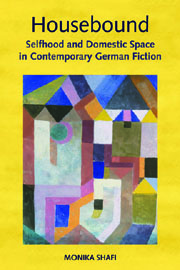Book contents
- Frontmatter
- Contents
- Acknowledgments
- List of Abbreviations
- Introduction
- 1 Bodies, Biographies, and Buildings: Jenny Erpenbeck's Heimsuchung and Katharina Hacker's Der Bademeister
- 2 House Inheritance: Arno Geiger's Esgeht uns gut and Katharina Hagena' Der Geschmack von Apfelkernen
- 3 Escaping to the Countryside: Walter Kappacher's Selina oder Das andere Leben and Monika Maron's Endmoränen
- 4 Uncanny Houses: Select Narratives by Judith Hermann, and Susanne Fischer's Die Platzanweiserin
- 5 Open Houses: Emine Sevgi Özdamar's “Der Hof im Spiegel” and Seltsame Sterne starren zur Erde: Wedding-Pankow 1976/77
- 6 (Un)safe Houses: Katharina Hacker's Die Habenichtse and Ian McEwan's Saturday
- Conclusion
- Bibliography
- Index
4 - Uncanny Houses: Select Narratives by Judith Hermann, and Susanne Fischer's Die Platzanweiserin
Published online by Cambridge University Press: 05 February 2013
- Frontmatter
- Contents
- Acknowledgments
- List of Abbreviations
- Introduction
- 1 Bodies, Biographies, and Buildings: Jenny Erpenbeck's Heimsuchung and Katharina Hacker's Der Bademeister
- 2 House Inheritance: Arno Geiger's Esgeht uns gut and Katharina Hagena' Der Geschmack von Apfelkernen
- 3 Escaping to the Countryside: Walter Kappacher's Selina oder Das andere Leben and Monika Maron's Endmoränen
- 4 Uncanny Houses: Select Narratives by Judith Hermann, and Susanne Fischer's Die Platzanweiserin
- 5 Open Houses: Emine Sevgi Özdamar's “Der Hof im Spiegel” and Seltsame Sterne starren zur Erde: Wedding-Pankow 1976/77
- 6 (Un)safe Houses: Katharina Hacker's Die Habenichtse and Ian McEwan's Saturday
- Conclusion
- Bibliography
- Index
Summary
The literary real estate market offers many different types of houses, and for the two authors featured in this chapter, Judith Hermann and Susanne Fischer, the most intriguing are the odd homes that defy standards of beauty and comfort. These are the ugly or decrepit places: the run-down house in the countryside, the bleak apartments or the shabby postwar row house evoking the uncanny, and the haunted house of the Gothic. Their strangeness reflects both contemporary conditions of globalization and Romantic and fin-de-siécle literary traditions. These buildings blur the lines between familiarity and strangeness, home and non-home, public and private, creating a pervasive feeling of malaise and boredom. Public venues — for example, the city, its roads and underground lines, or the darkened cinema — are often endowed with domestic features such as intimacy and shelter, while the domestic realm appears as uncomfortable, alienating, and even haunted. However, this “house of horror” is haunted not only by ghosts from the past but also by the horror of boredom and the horror of death. The houses in select fiction by Hermann and in Fischer's novel Die Platzanweiserin (The usherette) can thus be analyzed as expressions of the uncanny. Reading these texts through the lens of the uncanny will reveal that the houses disturb the characters' sense of grounding and that this uncertainty is both loathed and accepted, revealing itself at the places' uncanny core.
- Type
- Chapter
- Information
- HouseboundSelfhood and Domestic Space in Contemporary German Fiction, pp. 110 - 139Publisher: Boydell & BrewerPrint publication year: 2012



